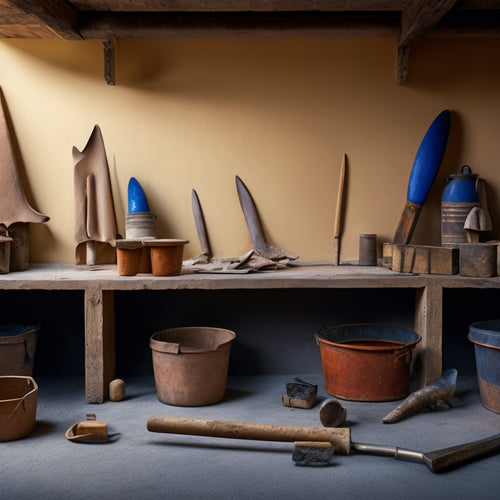
Best Concrete Saws for Small Renovation Projects
Share
You need a concrete saw that's both powerful and compact to tackle small renovation projects efficiently, as the right tool can make all the difference in precision, control, and overall project success. For small spaces, look for compact saws from top brands like Bosch, DeWalt, and Husqvarna, featuring high-torque motors, advanced cooling systems, and ergonomic designs. Consider electric or gas-powered options based on your project needs, and prioritize features like cutting depth, blade type, and weight. By understanding what to look for, you'll be well on your way to finding the perfect saw for your small renovation project - and that's just the starting point.
Key Takeaways
• Compact concrete saws are ideal for small renovation projects, offering enhanced maneuverability and precision in tight spaces.
• Electric saws are a great choice for small projects, being quieter, lighter, and more environmentally friendly than gas saws.
• Look for saws with high-torque motors, advanced cooling systems, and ergonomic designs to reduce fatigue and improve control.
• Prioritize compactness, precision, and control when choosing a saw for small projects, and consider budget-friendly options from DeWalt, Makita, and Bosch.
• Always follow safety essentials, such as wearing personal protective equipment and maintaining a clean work area, to ensure a safe and successful project.
Top Rated Concrete Saws
You'll find top-rated concrete saws that excel in performance, durability, and ease of use in the following list, carefully curated to meet the demands of small renovation projects. These saws are designed to tackle tough concrete cutting tasks while guaranteeing your safety and comfort.
When selecting a concrete saw, it's crucial to take into account top brands that have established a reputation for quality and reliability. Brands like Bosch, DeWalt, and Husqvarna offer high-performance saws that are backed by excellent user reviews.
Look for saws with features like high-torque motors, advanced cooling systems, and ergonomic designs that reduce fatigue and improve control.
User reviews are an excellent resource for gauging a saw's performance in real-world applications. Pay attention to reviews that highlight a saw's ability to cut through concrete efficiently, its ease of use, and its durability over time.
Best Saws for Small Spaces
When working in tight spaces, such as small bathrooms or kitchens, compact concrete saws that excel in maneuverability and precision become essential tools for completing renovation projects efficiently.
You'll appreciate the benefits of a saw that can navigate through narrow corridors and make precise cuts in confined areas. Look for saws with a compact design, which allows for better control and reduced fatigue. This feature is especially important when working in small spaces where you may need to make multiple cuts in a single area.
In these situations, the maneuverability benefits of a compact saw can't be overstated. You'll be able to make precise cuts with ease, even in areas with limited access. Additionally, compact saws are often lighter and more portable, making them ideal for small renovation projects.
When selecting a saw for small spaces, prioritize compactness, precision, and control. This will guarantee you can complete your project efficiently and safely, without compromising on quality.
Electric Vs Gas Concrete Saws
Concrete saws can be broadly categorized into electric and gas-powered models, each with its unique advantages and limitations that greatly impact their performance and suitability for small renovation projects. When choosing between these two types, you'll need to contemplate your specific needs and priorities.
In terms of performance comparison, electric concrete saws are generally quieter, lighter, and more environmentally friendly. They're ideal for indoor projects, as they don't emit fumes or exhaust. However, they may lack the power and cutting speed of gas-powered saws, which are better suited for heavy-duty outdoor projects. Gas saws also tend to be more portable, as they don't require a power cord.
From a maintenance perspective, electric saws are typically easier to maintain, with fewer moving parts and no oil changes required. Gas saws, on the other hand, require regular oil changes, air filter cleaning, and spark plug replacements.
You'll need to weigh these factors against your project requirements and personal preferences. By contemplating these key differences, you can make an informed decision and guarantee a safe, successful renovation project.
Key Features to Consider
As you narrow down your options between electric and gas-powered concrete saws, take into account the specific features that will make a significant difference in your small renovation project's success and efficiency. You'll want to think about the cutting depth, as this will impact the type of cuts you can make and the time it takes to complete the job. Additionally, blade types are essential, as they affect the saw's performance, durability, and maintenance requirements.
Here's a breakdown of key features to assess:
| Feature | Impact on Project | Importance Level |
|---|---|---|
| Cutting Depth | Affects type and speed of cuts | High |
| Blade Type | Impacts performance, durability, and maintenance | High |
| Weight and Ergonomics | Affects user fatigue and comfort | Medium |
When evaluating concrete saws, prioritize features that align with your project's specific needs. If you're working on a project that requires deep cuts, look for a saw with a higher cutting depth. If you're concerned about maintenance, opt for a saw with a durable blade type. By assessing these key features, you'll be able to choose the right concrete saw for your small renovation project.
Concrete Saw Safety Essentials
You must always wear personal protective equipment (PPE) when operating a concrete saw, including safety glasses, ear protection, and a dust mask. This protective gear is vital to prevent injuries from flying debris, loud noise, and airborne dust.
Additionally, make certain you're wearing sturdy boots, long pants, and a long-sleeved shirt to protect your skin from cuts and abrasions.
When it comes to cutting techniques, it's important to maintain a steady hand and follow a consistent pattern. Apply gentle to moderate pressure, depending on the type of concrete and the saw's power. Avoid applying too much pressure, which can cause the saw to kick back or vibrate excessively.
Keep your work area clean and well-lit to guarantee you can see what you're doing and avoid tripping hazards. Finally, always follow the manufacturer's instructions for the concrete saw and any specific safety guidelines for the project you're working on.
Budget-Friendly Options Available
Cost-conscious renovators can breathe a sigh of relief, as several budget-friendly concrete saw options are available on the market, offering a perfect blend of performance and affordability. You don't have to break the bank to get a reliable concrete saw for your small renovation project. Here are some affordable brands that have received positive user reviews:
| Brand | Price Range |
|---|---|
| DeWalt | $100-$300 |
| Makita | $150-$400 |
| Bosch | $200-$500 |
These brands offer a range of concrete saws that cater to different needs and budgets. DeWalt's concrete saws are known for their compact design and ease of use, while Makita's saws are popular for their high-torque motors and durability. Bosch's concrete saws, on the other hand, are praised for their precision and accuracy. When choosing a budget-friendly concrete saw, make certain to read user reviews and check the specifications to confirm it meets your project requirements. With these affordable options, you can get the job done without compromising on quality or safety.
Frequently Asked Questions
Can Concrete Saws Be Used to Cut Through Other Materials Like Asphalt or Brick?
When you're considering cutting through materials, you might wonder if concrete saws can handle more than just concrete. The answer is yes, but with caution.
You can use concrete saws for asphalt cutting, but the abrasive asphalt will wear down the blade faster.
For brick cutting, diamond blades are a must to prevent damage.
Always check your saw's specs and follow safety guidelines to guarantee a safe and successful cut.
How Often Should I Change the Blade on My Concrete Saw?
You should change the blade on your concrete saw regularly to maintain ideal cutting efficiency and guarantee your safety.
A dull blade can lead to reduced accuracy, increased vibration, and even kickback.
As a rule, inspect the blade after every 1-2 hours of use and replace it every 8-12 hours or when you notice visible signs of wear.
Proper blade maintenance is essential to achieving precise cuts and preventing accidents.
Are Concrete Saws Suitable for Cutting Curved or Irregular Shapes?
When you're dealing with curved or irregular shapes, you'll need to adapt your cutting techniques.
Not all concrete saws are created equal for these tasks. You'll want to opt for a saw type that's designed for precision, such as a ring saw or a demo saw with a curved blade.
These saws allow for more flexibility and control, making it safer for you to cut complex shapes.
Can I Use a Concrete Saw in a Wet or Humid Environment?
When working with concrete saws in wet or humid environments, you must take safety precautions and environmental considerations seriously.
You'll need to verify the saw is rated for wet conditions and follow the manufacturer's guidelines.
Additionally, wear protective gear, including waterproof clothing and eyewear, to prevent electrical shock and exposure to hazardous materials.
Always maintain a safe distance from water sources and avoid using the saw near open flames or sparks.
Do I Need a Special License to Operate a Concrete Saw?
When operating a concrete saw, you'll need to check local safety regulations to determine if a special license is required. Typically, it's not necessary, but you'll still need to undergo operator training to guarantee you're using the saw safely and effectively.
This training will cover essential safety protocols and best practices to minimize risks. Don't assume you can just start cutting; take the time to learn how to operate the saw correctly to avoid accidents and injuries.
Conclusion
As you navigate the complex landscape of small renovation projects, remember that the right concrete saw is your trusty compass, guiding you through the twists and turns of concrete cutting.
Just as a master chef wields a sharp knife, you'll wield your chosen saw with precision and confidence, conquering even the toughest concrete obstacles.
With the right tool in hand, the path to success is paved, and your project's foundation is solidified.
Related Posts
-

Create a Home Renovation Project Timeline in Excel
You can create a detailed home renovation project timeline in Excel by setting up a tailored template with separate w...
-

Streamlining Your Exterior Renovation Timeline
To streamline your exterior renovation timeline, start by identifying your project goals and objectives, and prioriti...
-

7 Best Plastering Bat Sizes for DIY Renovations
When tackling DIY renovations, you'll want to choose the right plastering bat size to achieve a professional-looking ...


